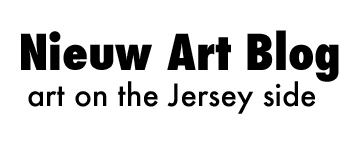by Peter Delman
6/26/23
The artists in NJ and Me: Imperfect Together embrace this lesson, no doubt without coaching from a cantankerous maestro. There’s hardly a middling horizon in sight, and glorious skies and evocative foregrounds are the result. Tim Daly’s low horizons and big skies give his luminous clouds room to roam. In Tim Heins’ Dusk, Jersey City, bands of enigmatic color blaze like chevrons across a banner of sky.
In movies the high angle (horizon at the top) is used to express vulnerability. In Dorie Dahlberg’s stark beach scenes, Love Before COVID 2 and New Year’s Day. Will This Be the Year?, a few isolated figures brave the cold winter winds in a vast expanse of sand. In contrast, the sun shines bright in the beach paintings by John Meehan III and Sue Ellen Ley. In Meehan’s Safari Towel the looming Dad silhouette balanced by the crouching figure in shadow gives the painting an extra jolt of Baroque energy.
Lots of attention is paid here to New Jersey’s urban scene, though just about everyone wisely gives contemporary architecture a wide berth. Alan Ostrowski’s loving drawings of the Bayonne bridge sparkle. Kevin McCaffrey’s Hoodsin County is an understated send-up of historical maps. You need to pay close attention to catch all the playful humor in this and his other works. McCaffrey cites Finnegan’s Wake as a major influence on his process. His lodestar is Joycean stream of consciousness, and these images deliver unpredictable surprise—even to him. The plot thickens when he discusses his former life as a Dominican priest, and there’s the flawless rendering of the map itself, which even divine inspiration can’t account for.
Anne Trauben’s portraits of Jersey diners capture the full brilliance of their iconic neon signs. (Kudos to Trauben for curating this ambitious, intelligent exhibition.) Christopher Z. is also intrigued by signs, which flow across his drawings with the grace of water. James Pustorino’s Wildwood photographs celebrate the engineering of some of our most gonzo, loopy creative minds. It’s a pleasure to see this gem of pop culture still preserved and being enjoyed to the hilt.
In Photo Sculptura 2, Jean-Paul Picard uses a glass brick wall as a ready-made distortion filter. There are echoes of art history evident here—cubist fragmentation, surreal mystery, the grid. But in the end, thanks to the instant karma of the camera shutter, the image is an up-to-the- minute shining artifact of the present.
“Sign on the window says lonely” is my favorite opening lyric by Bob Dylan—an apt tag line for New Jersey, to judge by much of the work in this show. The few figures on Dahlberg’s beaches punctuate their bleak emptiness. Tim Daly’s highways are more deserted than in the first week of COVID lockdown. No one ventures out onto the spooky dollhouse streetscapes of Jessica Rohrer’s Precisionist paintings. Rohrer describes these immaculate streetscapes as “sanitized” and “disturbing,” and agrees that The Rapture might conceivably begin on her block. They are based on drone stills, which may have something to do with why they bring to mind films like Blue Velvet and The Truman Show.
Lauren H. Adams goes right for the heart of desolation. Her discarded couches are a lesson in how mute objects are capable of speaking to us with achingly poignant eloquence.
I went to college in Vermont. My freshman-year student dorm counselor was from Oklahoma. He was very impressed with lush Vermont, but took great delight in mocking New Jersey as “the armpit of the nation.” I didn’t know then that much of the Garden State is just as green as the Green Mountain State. As for Oklahoma, it’s presumably OK.
Forty percent of New Jersey is forested, and several artists here speak for the trees. Doug Madill’s painting of Leonard Gordon Park captures, with expressively assured brush strokes, the golden light of a summer evening on urban trees. Edward Fausty’s exquisite photographs of woodlands are a moving testament to what we have and what we stand to lose—elegiac reliquaries for precious fragments of the true world. He describes his spherical images as evoking the experience astronauts have viewing the earth—"a living rock floating in the black void.” Fausty knows what it is “to see the world in a grain of sand.”
Viewing Eileen Ferara’s painting of the Hudson estuary, we imagine for a moment that the turbulent, unruly forces of nature have the power to hold at bay the “dark Satanic Mills” lurking in the background. I see Anne Percoco’s gentle installation Heap II as a riddle or koan: “when is a leaf not a leaf?” Is the pile of leaves, meticulously fashioned from paper street litter, a reproach, or something more ambivalent? So it goes in our imperfect New Jersey state of mind.
NJ & Me: Imperfect Together is curated by Anne Trauben.
Peter Delman is an artist living in Jersey City. Read Peter's bio here and view his artwork here.
Learn more about the exhibition and view images on Drawing Rooms website here.


